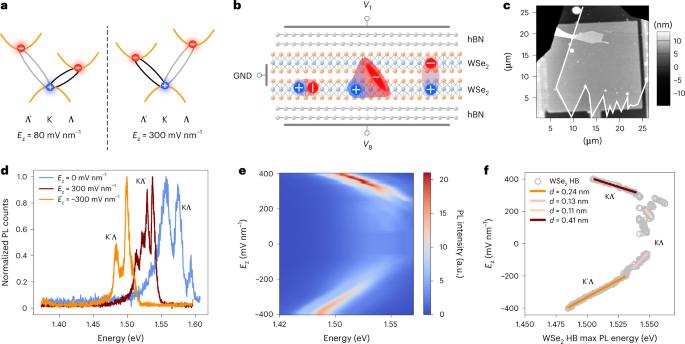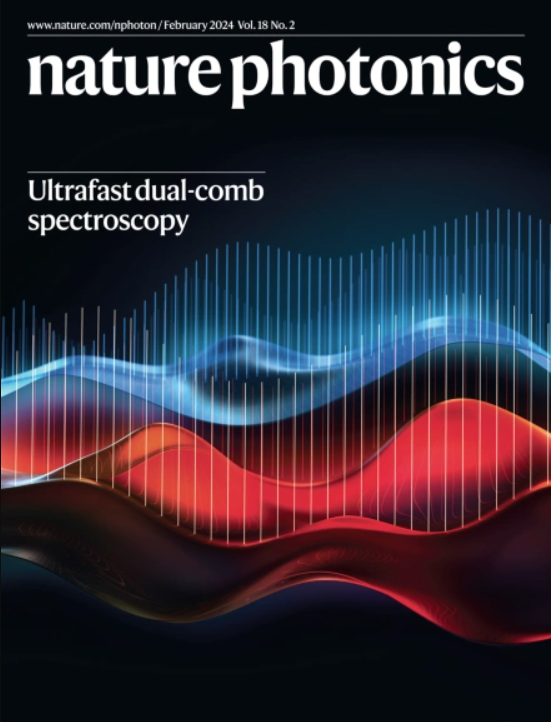Electrical control of hybrid exciton transport in a van der Waals heterostructure
IF 32.3
1区 物理与天体物理
Q1 OPTICS
引用次数: 8
Abstract
Interactions between out-of-plane dipoles in bosonic gases enable the long-range propagation of excitons. The lack of direct control over collective dipolar properties has so far limited the degrees of tunability and the microscopic understanding of exciton transport. In this work we modulate the layer hybridization and interplay between many-body interactions of excitons in a van der Waals heterostructure with an applied vertical electric field. By performing spatiotemporally resolved measurements supported by microscopic theory, we uncover the dipole-dependent properties and transport of excitons with different degrees of hybridization. Moreover, we find constant emission quantum yields of the transporting species as a function of excitation power with radiative decay mechanisms dominating over nonradiative ones, a fundamental requirement for efficient excitonic devices. Our findings provide a complete picture of the many-body effects in the transport of dilute exciton gases, and have crucial implications for studying emerging states of matter such as Bose–Einstein condensation and optoelectronic applications based on exciton propagation. The dipole-dependent propagation of hybrid excitons in a van der Waals heterostructure containing a WSe2 bilayer is characterized by modulating the layer hybridization and interplay between many-body interactions of excitons with an applied vertical electric field.

范德华异质结构中混合激子输运的电学控制。
玻色子气体中平面外偶极子之间的相互作用使得激子能够长距离传播。到目前为止,由于缺乏对集体偶极性质的直接控制,限制了激子输运的可调谐程度和微观理解。在这项工作中,我们通过施加垂直电场来调节范德华异质结构中激子的层杂交和多体相互作用之间的相互作用。通过在微观理论支持下进行时空分辨测量,我们揭示了具有不同杂化程度的激子的偶极依赖性质和输运。此外,我们发现传输物种的恒定发射量子产率是激发功率的函数,辐射衰变机制优于非辐射衰变机制,这是高效激子器件的基本要求。我们的发现提供了稀释激子气体传输中多体效应的完整图像,并对研究新出现的物质状态(如玻色-爱因斯坦凝聚)和基于激子传播的光电子应用具有重要意义。
本文章由计算机程序翻译,如有差异,请以英文原文为准。
求助全文
约1分钟内获得全文
求助全文
来源期刊

Nature Photonics
物理-光学
CiteScore
54.20
自引率
1.70%
发文量
158
审稿时长
12 months
期刊介绍:
Nature Photonics is a monthly journal dedicated to the scientific study and application of light, known as Photonics. It publishes top-quality, peer-reviewed research across all areas of light generation, manipulation, and detection.
The journal encompasses research into the fundamental properties of light and its interactions with matter, as well as the latest developments in optoelectronic devices and emerging photonics applications. Topics covered include lasers, LEDs, imaging, detectors, optoelectronic devices, quantum optics, biophotonics, optical data storage, spectroscopy, fiber optics, solar energy, displays, terahertz technology, nonlinear optics, plasmonics, nanophotonics, and X-rays.
In addition to research papers and review articles summarizing scientific findings in optoelectronics, Nature Photonics also features News and Views pieces and research highlights. It uniquely includes articles on the business aspects of the industry, such as technology commercialization and market analysis, offering a comprehensive perspective on the field.
 求助内容:
求助内容: 应助结果提醒方式:
应助结果提醒方式:


